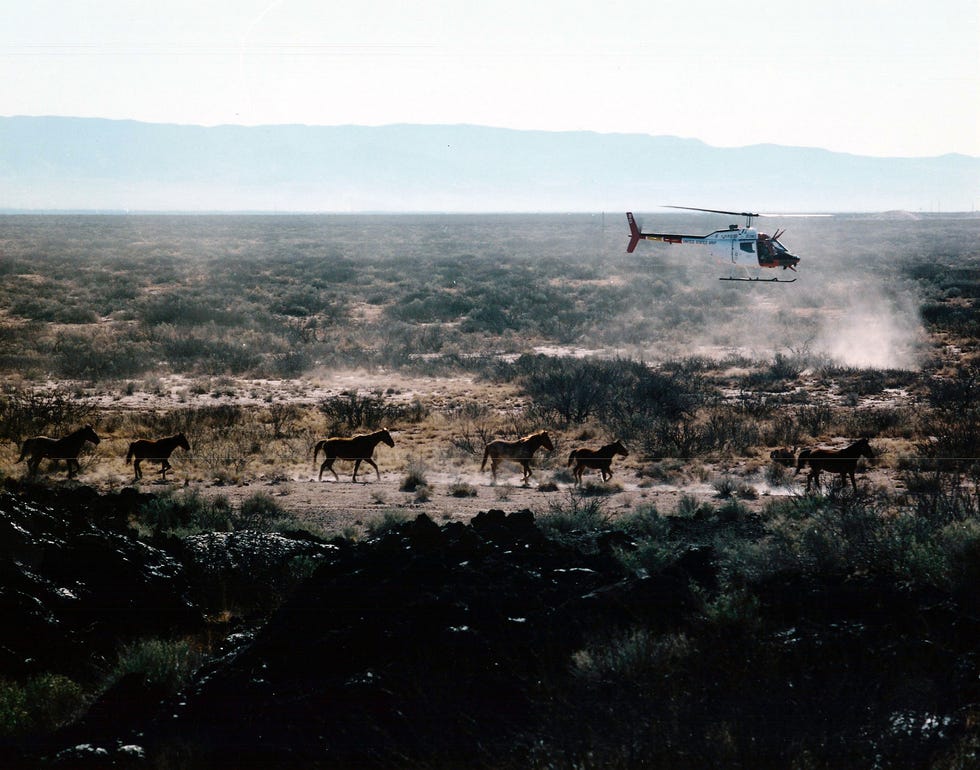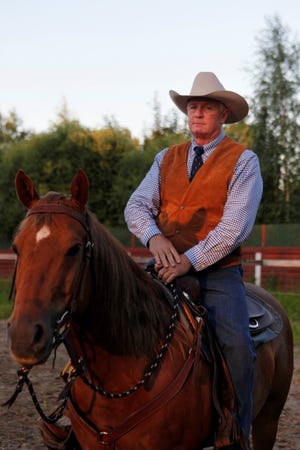[ad_1]
- Hoglund led the epic rescue of nearly 2,000 free-roaming horses from the missile range in 1995.
- He chronicled the adventure in his bestselling book “Nobody’s Horses.”
- Hoglund died Feb. 8 in Wisconsin after a short battle with cancer.
FARMINGTON — Even as he was confined to a hospital bed in Madison, Wisconsin, over the last few weeks, awaiting his own death, Don Hoglund remained true to his nature.
That’s according to his brother, Ray Hoglund, who said the former Santa Fe veterinarian refused to feel sorry for himself over his gloomy prognosis.
Don Hoglund had enjoyed a lifetime of adventure, traveling around the world caring for animals and teaching humans how to interact with them more effectively. But he was best known for leading the epic rescue of nearly 2,000 free-roaming horses on the White Sands Missile Range in southern New Mexico in the 1990s.
“He never said, ‘Why me?’ He never complained about it,” Ray Hoglund said by telephone from his home in the Atlanta area on Feb. 11, talking about his brother, who died on Feb. 8 after a short battle with cancer. “He just said, ‘Darn it, there were so many things I still wanted to accomplish.'”
Previously:Leader of epic White Sands horse rescue reflects on roundup 25 years later
Don Hoglund did his best to make sure those things were going to get done even after his death, his brother said. Ray recounted how Don, his trademark cowboy hat perched on his head, sat up in his hospital bed and mapped out a strategy for how his partners in his company, the Livestock Trust, could continue the firm’s work in his absence.
“He was just a cowboy to the end — no whining, no crying,” Ray said.
Don’s son, Ben Hoglund, remembered his father as a passionate man, one whose mind typically overflowed with plans.
“For every idea he had, he had a hundred more to support it,” Ben said. “He definitely was not risk averse. He took on just about any challenge.”
That included Don Hoglund’s work with the U.S. Department of the Interior’s wild horse prison inmate training program in Utah, Colorado and New Mexico, and especially his leadership of the White Sands horse rescue. Both were physically demanding and dangerous jobs that easily could have gone sideways, damaging Don’s professional reputation in the process.
But his father seemed to thrive under that kind of pressure, Ben said.
“He was definitely larger than life,” he said. “Most of the stories you hear about him, they’re all true. You can’t make that stuff up.”
Don Hoglund’s funeral services are pending. Ray said a memorial likely will be held in the spring in Northglenn, Colorado, where Don spent his high school years.

Don Hoglund embodied the cowboy way
Born to Katherine “Pat” June Hoglund and Carl “Red” Hoglund of Sterling, Colorado, on June 26, 1952, Don Hoglund was the fifth of nine children, five brothers and four sisters. He spent his formative years in Pueblo, Colorado, and early on developed a habit of roaming the high desert outside that town, Ray Hoglund said, recalling that the cowboy movie and singing star Gene Autry had a ranch near the family’s home.
“He’d ride his bike down there and hang out with the cowboys all day,” Ray said. “His love of horses and animals really started at a very young age and just progressed.”
The three middle Hoglund boys — Ray, Don and Dave — loved to set off across the desert with a sandwich, a bottle of water and their BB guns in search of adventure, Ray said. But even at that age, Ben Hoglund said, it was clear his father possessed a fearlessness that set him apart from his siblings.
“Back then, they didn’t really understand what that sort of motivation was,” he said. “Back then, he was always the first guy willing to jump off a cliff or take a gamble or forge new roads.”
The Hoglunds later moved to Northglenn, where Don developed into a hotshot high school basketball player and graduated from Northglenn High School in 1970.
Ray said Don married at a young age, a union that produced Ben, then enrolled at Colorado State University in Fort Collins, where he would go on to earn a bachelor’s degree in animal science, a master’s degree in agricultural economics and a doctorate in veterinary medicine. During that time, Don divorced and remarried and had a second child, a daughter named Alexandra.
After becoming a veterinarian, Don and his family settled in Santa Fe, where he opened a practice and developed friendships with many of that town’s Hollywood figures, including former Walt Disney Company CEO Michael Eisner, and actors Don Johnson and Melanie Griffith. That would lead to his involvement in several film and TV projects managing livestock for such productions as “Young Guns,” “Silverado,” “Desperado,” “Lonesome Dove” and “City Slickers.”
Hoglund also helped run the federal government’s wild horse training program for prison inmates at several institutions, including those in Santa Fe and Las Lunas, New Mexico. Ray said Don came to believe that if you gave someone the responsibility of caring for a wild creature, even a prison inmate with a violent past, both the horse and the man would benefit.
“That’s exactly what happened,” Ray said of the program.
Mike Callahan, a veterinarian who lives in Santa Fe and has a small practice in Pecos, New Mexico, was recruited by Don to join him in the program. Callahan recalled it as tense but highly rewarding work.
During the program’s run, Callahan said, the recidivism rate for participants fell significantly as they learned to use their work to channel their emotions in a positive way. To this day, he marvels at how some inmates let their hardened exterior melt away in the presence of an animal.
Callahan related the story of how a blue heeler dog had hitched a ride on a bus used in the program and found his way into one of the New Mexico detention facilities. One of the inmates participating in the program was spotted by Hoglund holding the dog tenderly and petting it.
The inmate — serving a lengthy sentence for homicide and “a mean dude,” as Callahan put it — was bawling his eyes out.
“He said it was the first time in years he had petted a dog,” Callahan said.

Coming to the White Sands rescue
As his brother’s career and reputation progressed, Ray said, Don became more and more interested in the interaction between humans and animals. Eventually, Don became what Ray called an animal behavioralist — someone who specialized in teaching humans how to interpret the behavior of a horse, cow or dog and who could advise them on how to use that information to get the animal to respond in the desired fashion with a minimum of stress.
Don would need to put all those instincts to good use in his next high-profile assignment — the roundup and rescue of hundreds of free-roaming horses from the White Sands Missile Range nearly 30 years ago. The horses were the descendants of animals left behind by ranching families ordered to hastily leave the area by the federal government during World War II as the site was turned into a top-secret U.S. Army base. Therefore, they were considered feral horses, not wild horses, and were outside the protection of the landmark 1971 federal law designed to protect and preserve their kind.
The horse herd that remained on the 3,200-square-mile base thrived despite the challenging conditions and eventually grew to more than 2,000 head by the 1990s. But the range they roamed had become ravaged by drought and could no longer sustain them. Horses began dropping dead by the dozens from starvation and lack of water, drawing international media attention and setting off a public relations crisis for the Army, the Pentagon and the state of New Mexico.
Don, who was considered by government officials to be uniquely qualified for the task, was brought in — not exactly enthusiastically, as he recalled — to clean up the mess. After some soul searching, he realized he was obligated to do whatever he could to ease the suffering of the animals, who were wandering the range amid tons of unexploded army ordnance while not getting enough to eat or drink.
“They trapped me inside my (veterinary) oath,” Hoglund told The Daily Times in a July 20, 2019, story that recounted the complexities of the rescue operation as its 25th anniversary approached.
Hoglund may have groused about being prodded into leading the effort — a highly dangerous proposition for both the horses and the cowboys and vets who took part in it — but he knew he couldn’t say no.
“You give that oath, you better keep it,” he said.

Once again, Hoglund recruited his pal Callahan to join him. Callahan said there was no point in his trying to resist Hoglund’s entreaties.
“He had a lot of charisma and a lot of charm,” Callahan said. “People gravitated toward him. It was just his nature that you wish you could emulate.”
Hoglund’s son Ben confirmed Callahan’s assessment of his father’s persuasive qualities.
“He had an engaging personality and could convince people to follow him always,” he said.
Over the next year and a half, Hoglund would serve as the hands-on leader for the roundup, which was accomplished with the aid of helicopters, all-terrain vehicles and old-fashioned cowboys on horseback. After they were detained, the animals were provided with medical attention, fed and watered, and nursed back to good health before being offered for adoption at events throughout the western United States. Today, a handful of those horses survive, galloping across green pastures from Oklahoma to California.
Years later, Hoglund would chronicle the operation in a bestselling book, “Nobody’s Horses,” one of only several books he wrote over the course of his life. Hoglund described the rescue as the highlight of his career in that 2019 interview with The Daily Times.
Previously:Leader of epic White Sands horse rescue operation reflects on months-long roundup 25 years later
But he also acknowledged he remained deeply conflicted about the project a quarter century later.
“There are multiple edges of that sword,” he said. “I saved some lives, but I also removed the freedom of those horses.”
His brother Ray seemed to understand exactly what Don was talking about during that interview as he recalled his brother’s spirit this week. In many ways, Ray said, Don was a human version of those free-roaming horses.
“His fierce independence and passion almost bordered on the wild,” he said. “He wanted to live wild and free.”
Don Hoglund legacy and obligation
An important element of Hoglund’s legacy is his book “Nobody’s Horses,” and he had dreamed for many years of having it made into a feature film or a limited television series. Shortly before he died, Hoglund came to an agreement with Courtney Graham, cofounder and producer at Glamazon Pictures, a boutique film and TV production company based in Toronto, for her to option the book, his life story and some scripts he had written based on his experiences.
Graham — who also has worked in the camera department on dozens of feature films and TV series, including the recently released “Nightmare Alley” starring Bradley Cooper and Cate Blanchett, and the 2017 romantic fantasy film “The Shape of Water,” which won the Oscar for Best Picture — had worked with Hoglund on the project since meeting him more than six years ago through a mutual acquaintance.
During a phone interview on Feb. 11, she recalled that Hoglund was the first cowboy she had ever met, and she described how he had charmed her with his “cowboy speak” and chivalrous habits. Over time, she said she came to realize that he shared a good many traits with her late father, something that solidified their bond.
Graham said their work together took on a new urgency after Hoglund fell seriously ill late last year and realized he had only a short time left.
“In the last year, we had been much more intensely working together to get the project where it can be pitched to a major production company in hopes of getting it onscreen,” she said.
When Graham learned Hoglund had been hospitalized in January, she said she rushed to his bedside.
“I flew out as soon as I could, and I needed to break some professional promises to people (to do it),” she said. “But I don’t regret it for a second.”
The two spent an entire day talking and laughing, Graham said. She became emotional when she described how much Hoglund’s friendship meant to her.
“I wasn’t in his family, but as I got to know him more, he treated me more like a daughter,” she said. “He always believed in me. He inspired me.”
Graham said she feels a deep sense of obligation to Hoglund’s family, and to Hoglund, to see that “Nobody’s Horses” finally makes it onto the screen. Her plan is to pitch it as a series to Netflix, stretching it out over four or five seasons using that tale and others from Hoglund’s life, including his work with prison inmates.
“He certainly lived an extraordinary life,” she said. “Some people might refer to him as a dreamer, but I challenge that. I would call him a big idea guy. To him, nothing was impossible.”
Graham said she is convinced the planets have aligned in Hollywood for a story like “These Horses” because of the recent success of the TV programs “Yellowstone” and “1883,” both Westerns that have found an enthusiastic following. She views “These Horses” as a tale that slots perfectly in between those two vehicles.
“That’s why I truly believe the time for this story is now,” she said. “‘Nobody’s Horses’ is a story that fits in the middle. It embraces some of the same themes.”
Despite her fondness and admiration for Hoglund, Graham said she has visited with his family members enough to realize he had his faults like anybody else, noting that his work often led him to be absent from their lives for extended periods of time. His son Ben confirmed the toll that took on the family.
“Sometimes, it was hard on the people around him that he cared about,” he said. “But, really, it was the only way he knew how to be.”
Hoglund also continued to struggle with his decision to lead the White Sands roundup, Graham said, never letting himself off the hook for the downside of that action.
“He debated the merits of what he did right up to the end,” she said, explaining that she hopes to convey that tension in her adaptation of the book. “Was he on the side of good or the side of bad?”
As Callahan reflected on the loss of his friend this week, he took a lighter approach. He explained that while he will miss Hoglund greatly, he couldn’t help but share a chuckle with Don’s brother Ray as they discussed Don’s famously loquacious style and gift for getting folks to see things his way.
“I told Ray, ‘Knowing Don, I can’t believe he didn’t talk his way out of this deal,'” Callahan said.
Mike Easterling can be reached at 505-564-4610 or measterling@daily-times.com. Support local journalism with a digital subscription.
[ad_2]
Source link















